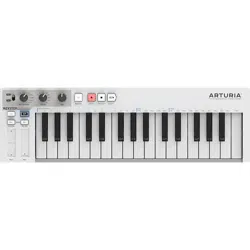Loading ...
Loading ...
Loading ...

8.10.4.2. Gate CV Output
We’ve included three types of Gate signal response:
S-trig: This stands for "Short-circuit trigger", though sometimes it’s called "negative trigger".
It involves keeping the voltage high and then shorting the trigger circuit whenever the note
should play. This format is used by Dr. Bob’s classics, Korg and Yamaha synths, among
others.
V-trig: An abbreviation for "Voltage trigger", also known as "positive trigger". This method
involves keeping normally low voltage on trigger and producing a fixed positive voltage to
indicate a note is on. It’s favored by Roland and Sequential Circuits synths and others as
well.
8.10.4.3. MIDI Note reference (0V, 1V)
KeyStep provides the option to set a separate reference note for both Volt per Octave and
Hertz per Volt formats. This parameter will change from a 0V reference to a 1V reference
depending on which Pitch CV Output option is selected.
Volts per octave uses a 0V MIDI note reference
Hertz per Volt uses a 1V MIDI note reference
8.10.4.4. Note Priority
Since CV connectors are always monophonic, it’s important to be able to determine which
note from a polyphonic sequencer track or keyboard will be interpreted as the one the mono
synth on the other end should play.
And even some mono synths prefer one or the other of the three choices KeyStep gives you:
Low note priority, High note priority, or Last note priority.
8.10.4.5. Mod CV source
This parameter determines which KeyStep feature will send signals to the Mod CV output:
the Mod strip, velocity or aftertouch.
8.10.4.6. Mod CV max voltage
Each of the three sources has a ‘zero’ point that translates into 0 Volts. This parameter lets
you specify whether the range will be 0-5V, 0-6V, etc., on up to 0-12V.
Arturia - User Manual KeyStep - MIDI Control Center 72
Loading ...
Loading ...
Loading ...
